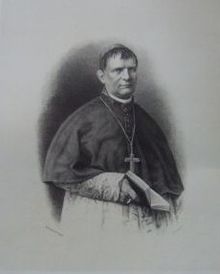Sisto Riario Sforza
Sisto Riario Sforza (born December 5, 1810 in Naples , † September 29, 1877 ibid) was an Italian clergyman, Roman Catholic Archbishop of Naples and cardinal .
Life
Sforza, who belonged to the noble houses Riario and Sforza , was born in Naples. He was the son of Giovanni Antonio Riario Sforza and his wife Maria Gaetana Cattaneo della Volta. His uncle was Cardinal Tommaso Riario Sforza .
Sforza attended the Pontifical Roman Seminary , the Pontifical Diplomatic Academy and the La Sapienza University in Rome . On April 23, he was awarded the degree of Doctor of Theology . He got the habit on January 1st, 1825 and on February 13th, 1825 his hair was shaved off for the tonsure for the first time . He received minor orders on December 25, 1826 and was ordained a subdeacon on April 21, 1832 . On September 1, 1833 he received in Naples by the Archbishop of Naples Filippo Giudice Caracciolo the priesthood .
He worked for many years as Maestro di Casa dei Sacri Palazzi and in 1865 and 1866, as treasurer of the Holy College of Cardinals, took care of the finances of the College of Cardinals . He was also canon of the Vatican Basilica and private secretary to the Pope in 1841.
As secretary of the memorials he accompanied Gregor XVI in 1842 . on his trip to Umbria and Rieti . He contributed to the conversion to the Roman Catholic faith of Otto-Magnus von Stackelberg and Demetrius Augustinus Gallitzin . King Ferdinand II proposed him to the Pope as Bishop of Aversa on April 24, 1845 .
After he was appointed Papal Assistant to the Throne on May 17, 1845, Cardinal Mario Mattei , the Cardinal Bishop of Frascati , donated him to the episcopal ordination on Sunday, May 25, 1845 in a side chapel of St. Peter's Basilica ; Co -consecrators were Archbishop Ludovico Tevoli , almsman of His Holiness , and Archbishop Luigi Maria Cardelli, OFM, Canon of St. Peter's Basilica.
Ferdinand II , King of the Two Sicilies , proposed him on September 6, 1845 for the Archbishopric of Naples. The Pope made him Archbishop of Naples on November 24, 1845 and sent him the pallium on the same day . Sisto Riario Sforza headed the Archdiocese of Naples until his death . On January 19, 1846, Pope Gregory XVI took him . with a dispensation , because his uncle was also a cardinal, as a cardinal priest with the titular church Santa Sabina in the college of cardinals . He took part in the conclave of 1846 , from which Pope Pius IX. emerged, part.
After the collapse of the Kingdom of the Two Sicilies, Sforza was forcibly exiled from September 1860 to July 1861 and from 1862 to 1866. From 1869 to 1870 he took part in the First Vatican Council , in which he spoke out against the dogma of papal infallibility .
Sisto Riario Sforza died on September 29, 1877 at the age of 66 after a long illness and was buried in the Cathedral of San Gennaro in Naples.
Aftermath
While Pius IX. as his "right hand" appreciated, said his successor Leo XIII. that he would not have been elected Pope if Cardinal Sforza had been alive at the time of the conclave .
The process for his beatification began in Naples in 1927. On June 28, 2012, Benedict XVI recognized the heroic degree of virtue Sisto Riario Sforzas and raised him to Venerable Servant of God
Web links
- Riario Sforza, Sisto. In: Salvador Miranda : The Cardinals of the Holy Roman Church. ( Florida International University website), accessed December 12, 2016.
- Entry on Sisto Riario Sforza on catholic-hierarchy.org ; accessed on December 12, 2016.
Individual evidence
- ↑ Venerabile Sisto Riario Sforza on santiebeati.it
- ^ Decrees of the Congregation for the Causes of the Saints
| predecessor | Office | successor |
|---|---|---|
| Filippo Giudice Caracciolo |
Archbishop of Naples 1845–1877 |
Guglielmo Sanfelice D'Acquavella |
| Francesco Saverio Durini |
Bishop of Aversa 1845–1845 |
Antonio Saverio De Luca |
| personal data | |
|---|---|
| SURNAME | Riario Sforza, Sisto |
| BRIEF DESCRIPTION | Italian clergyman, Archbishop of Naples and cardinal |
| DATE OF BIRTH | December 5, 1810 |
| PLACE OF BIRTH | Naples |
| DATE OF DEATH | September 29, 1877 |
| Place of death | Naples |

